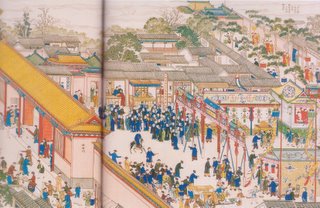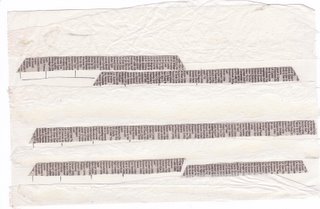This scan from the RA Magazine gives an idea (but of course as it’s so far removed from the original, the colours are off and details fuzzy).

In the article, David Hockney says: “The fact that the scroll cannot be reproduced in a book should tell us it has modern relatives – the more recent kind of ‘scroll art’ that we see in movies and video. But the ancient scroll, which is unfurled by the viewer, offers more possibilities for viewer participation than a film in which the cameraman decides what we see.”
The viewer isn’t static, unrolling the scroll - as in life: our eyes move all over the place. The isometric perspective used doesn’t have a vanishing point. If it had a vanishing point (as in Western perspective) “the viewer would be a pinpoint in front of the picture instead of a physical participant in the viewing of the scroll... The Chinese method of painting is more narrative, more attuned to the movements of the viewer’s eye and body and their psychological engagement with the story they are unfurling.”
As part of a drawing course based around the Chinese galleries at the V&A in June 1992, we saw a video of Hockney looking at and talking about a Chinese scroll (I'd love to see it again). He may have mentioned how elements like fog help with that feeling of moving through space. At the time I went home and “evoked” fog among the buildings with some tissue paper and the financial pages from the newspaper:
 Looking at that now, I feel a quilt coming on ... but it's the first day of the new term of Chinese classes, and time to pack up and head into town. Somehow, during the break, though I'd planned (or hoped) to do some revision or reading every day, it didn't happen most days. In fact I seem to have forgotten just about everything learnt over the past 3 years. Use it or lose it!
Looking at that now, I feel a quilt coming on ... but it's the first day of the new term of Chinese classes, and time to pack up and head into town. Somehow, during the break, though I'd planned (or hoped) to do some revision or reading every day, it didn't happen most days. In fact I seem to have forgotten just about everything learnt over the past 3 years. Use it or lose it!
No comments:
Post a Comment